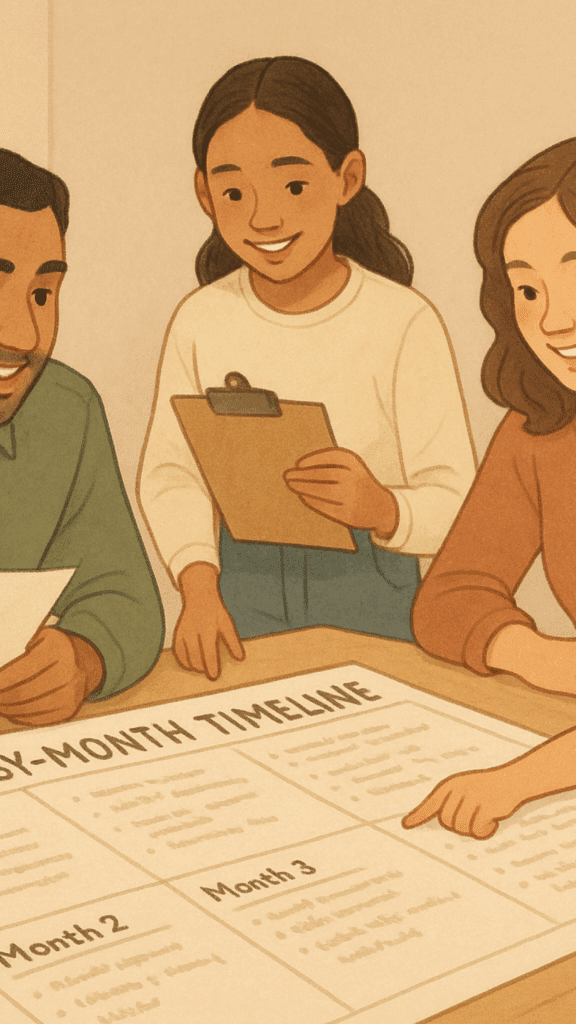Family Moving Timeline
Your Month-by-Month Plan to Upsize Smoothly (Without Losing Your Mind)

Short on time?
Download the guide now to save it for later – and keep it handy whenever you need it.

Why You Need a Plan
You’ve decided to upsize – now comes the hard part: making it all happen. Between school schedules, showings, financing, packing, and settling into a new home, it’s easy for chaos to creep in.
That’s why we created this guide. With a clear, month-by-month roadmap, you’ll know what to expect, what to do when, and how to keep your family’s life as uninterrupted as possible during this big transition.
How Long Does a Family Move Take?
Most family upsizing moves take 3 to 5 months. That includes:
- Mortgage and financial prep
- Selling your current home
- Buying your next home
- Coordinating packing, staging, and closing dates
A realistic timeline gives you room to breathe. You can move at a pace that works with your kids’ school schedules, partner availability, and family obligations - without rushing important decisions.
Life Stage vs. Lifestyle:
Why Families Upsize (And When)
Families upsize for many reasons, but they usually fall into one of these categories:

Month 1: Plan & Prepare
- Book your home valuation with your real estate agent
- Schedule your mortgage pre-approval
- Begin decluttering (donate or store non-essentials)
- Create a wishlist for your next home (bedrooms, layout, school zone, commute time)
- Research neighbourhoods that fit your lifestyle
Month 2: List & Look
- Finalize home prep and staging
- List your current home
- Begin touring potential new homes
- Meet with legal and financial pros (real estate lawyer, mortgage advisor)
- Have a family discussion about ideal move dates and expectations
Month 3: Offers & Alignment
- Accept an offer on your home
- Make offers on homes you’ve shortlisted
- Work with your agent to align closing dates on both properties
- Start early packing of storage items, off-season clothing, and decor
Month 4: Final Prep
- Confirm movers, storage, and cleaning services
- Notify schools, employers, and utility providers of your upcoming move
- Finish room-by-room packing, labeling everything clearly
- Prepare an “essentials box” with first-night items (toys, chargers, toiletries, etc.)
- Host a small family night or goodbye dinner in your current home
Family-Focused Tips for Each Stage
Let’s break this down realistically:
With School-Age Kids:
Try to plan your move during a school break, like summer or March break. Let them help choose their new room or even their new school to ease the transition. Keep routines consistent right up to moving day.
Multigenerational Moves:
Plan ahead for medical needs, cultural or religious considerations, and caregiving schedules. Look for homes with accessible layouts that suit everyone’s mobility and privacy needs.
With Toddlers or Babies:
Designate one “safe room” to minimize chaos during packing. Keep comfort items like toys, snacks, and bedtime essentials readily available. If possible, arrange for childcare on moving day.
With Pets:
Set up a calm, quiet space during open houses to reduce stress. On moving day, consider using a pet sitter or boarding service. Pack their essentials -food, bed, and toys - last so they stay calm and feel secure.
What Should You
Do Next?
If You...
Then...
Just decided to upsize
Want help with your specific plan
Final Thoughts
Upsizing is a major milestone for any family – and it doesn’t have to feel overwhelming. With a clear plan and the right support, your next move can feel less like a logistical nightmare and more like a smooth transition to a better lifestyle.
You focus on the family. We’ll handle the roadmap. Let’s make this your smoothest move yet.

